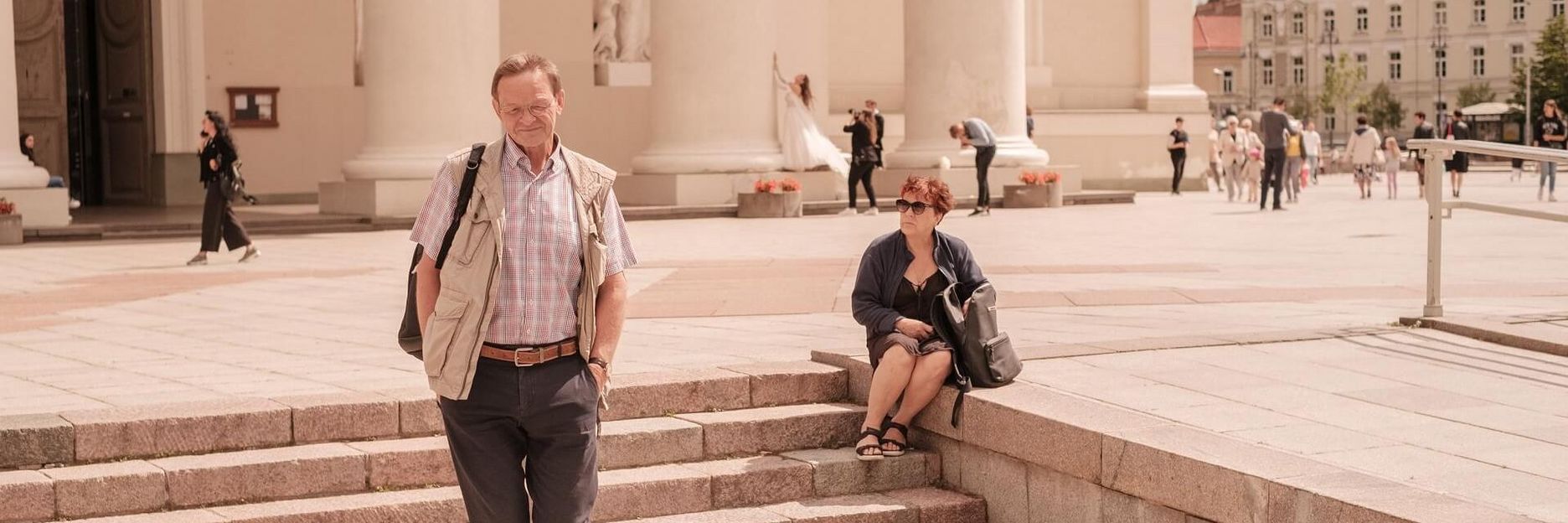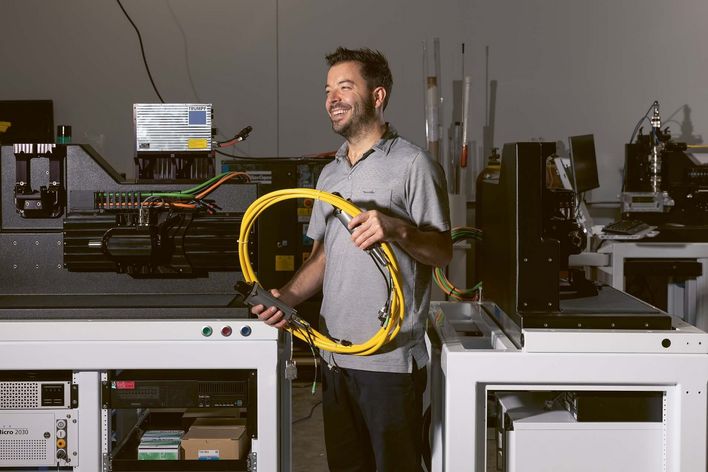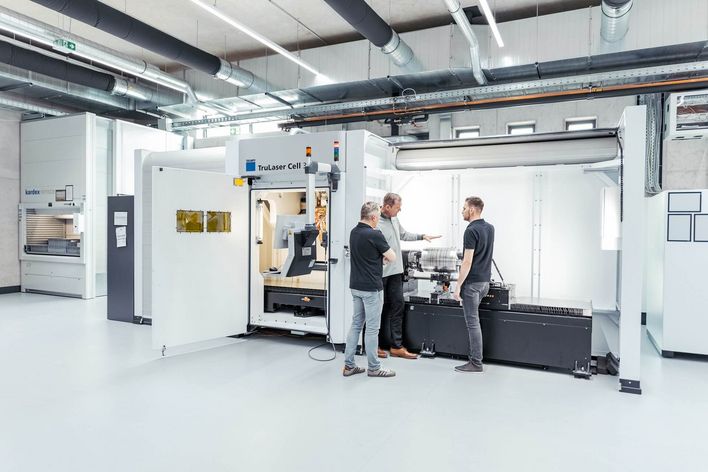Mr. Račiukaitis, are people surprised when you tell them about Lithuania’s laser industry?
Račiukaitis: Yes, it happens all the time.
Why is that?
Račiukaitis: We’re a small country of not even three million inhabitants, a former Soviet republic that joined the European Union less than 20 years ago. We’re used to people underestimating us. But we’ve had laser technology since 1966 – longer than most other countries in the world.
Why so long?
Račiukaitis: Basically, Lithuania’s laser industry can be traced back to three students who were all sent to Moscow in 1962 to study quantum electronics – and, with it, the emerging field of laser technology. They helped fire the first laser in Lithuania in 1966 and went on to found the Laser Research Center at Vilnius University and the Center for Physical Sciences and Technology – which is where I am now head of the Department of Laser Technologies. Anyone in Lithuania with anything to do with lasers has some sort of connection to at least one of these bodies, and usually to both of them. They’re only 20 kilometers apart. Commercial lasers for science have been built in Lithuania since 1983.
What’s the situation in Lithuania’s laser industry right now?
Račiukaitis: We’ve more than 50 companies manufacturing lasers or optical components for lasers. Together, they employ around 1,400 people and generate annual revenues in the region of 176 million euros.
That’s not a lot.
Račiukaitis: No, it’s not. But if you have a mobile phone, you can be pretty sure it contains a part that was made by Lithuanian USP lasers. For certain high-tech systems, our small country can hold its own with the U.S., China or Germany.
What do these companies make?
Račiukaitis: We’ve always been a strong player in the field of scientific lasers. Right now, we’re working on some of the most intense lasers in the world, as part of the Extreme Light Infrastructure (ELI) project, a European research initiative. It’s around 15 years since the first Lithuanian companies began producing lasers and optical components expressly for the industry. Our market breakthrough was the commercialization of the USP laser – an area where we’ve played a strong role from the very beginning. These days, we’ve a whole spectrum of manufacturers producing lasers and laser-processing machines, or optical components such as coated lenses, or optical parametric oscillators. OPOs are used to convert and amplify laser light. Ninety percent of all OPOs sold worldwide are made in Lithuania. There are also a number of contract manufacturers operating here – companies with laser machinery who provide high-end laser-processing services such as glass cleavage. Right now, several companies are moving into medical engineering.

»If you have a cellphone, there’s every chance that some of the com-ponents were manufactured with a USP laser made in Lithuania.«
Gediminas Račiukaitis is head of the Department of Laser Technologies at the Center for Physical Sciences and Technology in Vilnius. His research interests include the laser-induced generation of high-energy electron beams and selective metallization by laser for applications in electronics. He is also president of the Lithuanian Laser Association and has been involved in the development and growth of the country’s export-led laser industry from its earliest days.
What is Lithuania’s flagship product in the laser market?
Račiukaitis: If I had to choose an area, then it would be OPCPA, a technology that is used to amplify ultrashort laser pulses. Lithuanian companies have played a strong role in this field for a long time. In general, when it comes to USP lasers and their components, we’re competing on even terms with the rest of the world. For me, that’s great to see, because these are all cutting-edge technologies that will enable us to build lasers of ever-greater intensity.
And who do you sell all these products to?
Račiukaitis: They all go abroad. Sadly, there aren’t many Lithuanian companies that use laser technology in their manufacturing. That’s a drawback compared to Germany, for example, where there are lots of opportunities to meet up with companies and even take a look at their production facilities. That makes it much easier to sound them out and find out what they really need. Here, in Lithuania, we’re also looking at ways of getting more feedback from end users. But since they don’t come to us, we have to go to them. Right now, the Lithuanian Laser Association is organizing a visit to companies in Korea and Taiwan.
What’s the secret behind Lithuania’s success in laser technology?
Račiukaitis: That sometimes it’s good to be small. It means that we all know each other personally. Most companies are spin-offs from the leading institutes, and most of the company founders and workforce are of the same age as the people from the other companies and the institutes and know each other because they all studied together. It’s very common to move from academia to industry and back again. As a result, research and development at the institutes are strongly geared toward what companies actually require. In the laser community, we all trust each other – even across company boundaries. Sure, we’re still market rivals, but companies here tend to work together rather than against one another. In the photonics world, I’d say that’s pretty unique.
How does the country itself benefit from Lithuania’s remarkable success in the photonics industry?
Račiukaitis: Well, first of all, in ways you might expect: it gives us a stronger economy, global prestige … But there’s also something else, even more important: a home for my fellow Lithuanians.
What do you mean by that?
Račiukaitis: In Lithuania, when it comes to choosing a career, people often look abroad. Ideally, you study at Oxford – no matter the subject, no matter how successful – and then go on to work in Sweden or in Germany. For some people, that’s great. But, in the process, you end up losing your roots, and many people are unhappy about this. The fact that Lithuania has a flourishing laser industry means that young people are now able to imagine having a bright future for themselves back home, complete with an exciting and well-paid job. That’s the best way of stopping the brain drain. It’s something I see year after year: the desire to stay at home, here in Lithuania.
Where do you see it?
Račiukaitis: Each year, 40 out of 50 of the new intake of physics students opt to major in laser physics or laser technology. Things are quieter in the corridors of the other physics departments because there is no collaboration with industry there. Of course, even without that, laser technology is still a great field. But primarily, it offers great prospects. And young people recognize that.
What does the future hold in store for laser technology from Lithuania?
Račiukaitis: Over the period from 2009 to 2021, our photonics industry grew year on year by 16 percent. That’s huge growth, and I see it continuing at a similar level. In turn, this will mean tapping into more markets, so that there is an outlet for this growth. Our job, at the Laser Association, is to help make this happen. As for new applications of this technology, I see good opportunities in the fields of optical and quantum optical communication. In fact, I’m already seeing the first evidence of commercial activities in this direction. And, soon, there will be more on the way.
Do you have any advice for other countries?
Račiukaitis: If you don’t use lasers in science and industry, then everything eventually grinds to a halt. Everything goes dark.





